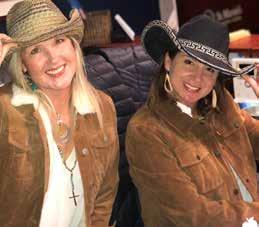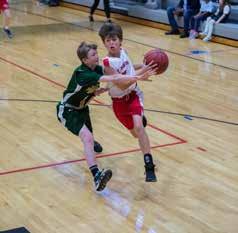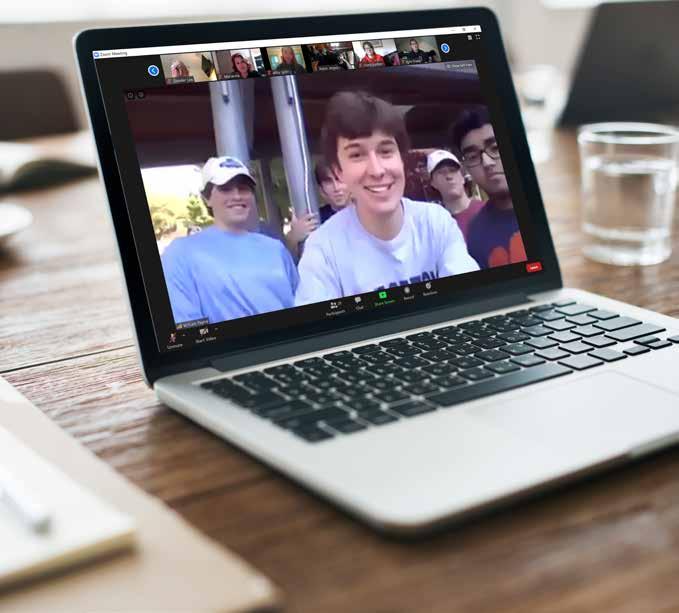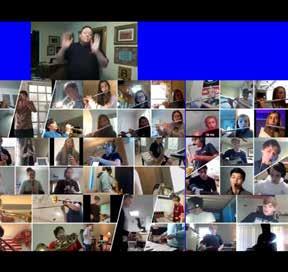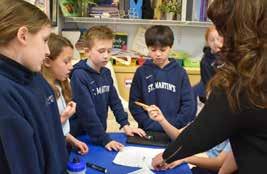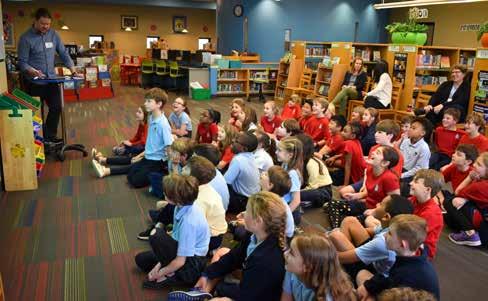
24 minute read
Building Cultural Competence
T he Artistry of Building Cultural Competence
by DR. TIFFANY RUSSELL DIRECTOR OF DIVERSITY & INCLUSION
Advertisement
Imagine a blank canvas. Picture an artist standing in front of the canvas with tools, various colors of paints on a palette, and paintbrushes. Where do they begin? With a vision for the future, an experience from the past, or a story that builds connection between the artist and viewer? The act of an artist creating a masterpiece is similar to an individual’s journey toward building cultural competence; it requires vision, reflection, creativity, practice, and lifelong exploration.
Defining
DEFINING CULTURAL COMPETENCE
Cultural competence, loosely defined, is a person’s ability to understand, appreciate, and interact with people from cultures or belief systems different from their own. Cultural competence is as much about our relationships with other people as it is about understanding our own cultural background and heritage. Like other types of competence, cultural competence is developed over time through training, experience, guidance, and selfevaluation.
The most recent acts of violence and subsequent demonstrations for racial justice have quickened the self-evaluation process on a myriad of levels: individual, communal, and institutional. We are faced with an opportunity to build our competence. We can listen to the stories of the people and communities impacted by racial profiling, discriminatory treatment, and violence and then act in meaningful ways on behalf of them. Or we can do nothing. And, doing nothing is not a choice for us at St. Martin’s. At St. Martin’s we encourage this journey of exploration and reflection. How can we not? As educators and artists, it is our duty to help our students to develop a sense of the world that is expansive, one that should be equitable for all. Most importantly, we must encourage our students to ask why this is? Asking this question alone is the beginning of building cultural competency. To understand cultural competence, it is important to first grasp the full meaning of the word ‘culture.’ Merriam-Webster defines culture as the values, norms, and traditions that affect how we think, act and make judgments about our world. Culture is the fundamental building block of our identities. Culture also includes the customs, arts, social institutions, and achievements of a particular nation, people, or other social group. In other words, culture is represented in our homes, our places of worship, and our schools and many other places.
Relationship building is fundamental to cultural competence and is based on the foundations of understanding each other’s expectations and attitudes, and subsequently building on the strength of each other’s knowledge. It requires trust and vulnerability, so if we mess up along the way, we are forgiven and can learn from the experience. Our environment determines what we learn, how we learn it, and the rules for living with others. These rules are transmitted from one generation to the next and when we add competence it signifies the ability to understand
and effectively interact with people across cultures while being aware of one’s own beliefs. For our children, their competency grows with every new book they read, new friend they make, new teacher they meet, field trip or art exhibit they visit, and study abroad or cultural experience they have. Each year, the St. Martin’s curriculum evolves to include more of these experiences to help prepare students to live and work in a diverse world. A noteworthy example is the Panamá Exchange Program, which offers St. Martin’s Middle School students the opportunity to travel to Panamá for an immersive learning experience or to host a Panamanian exchange student in their home. Another example is the Multicultural Book Nook. The nook, located in Warrior Hall, is a shared resource for all teachers and boasts a full range of books in a variety of reading levels that support social-emotional learning, cultural competency and social justice. There are also less prominent moments, like facilitated conversations in the classroom about the day’s history lesson, participation in student vestry and the missions of both the SOLVE and RELATE clubs, that slowly help build cultural competence in St. Martin’s students. Cultural competence is an ongoing and rewarding process of intellectual curiosity, intentional learning, and critical thinking about one’s own views and the views of others. Taking this approach results in many benefits for the individual and their community. For example, when individuals consider ideas different from their own, stronger relationships and collaboration between people of differing cultures and nationalities within the community can take root. These communities then, grounded in deeper understanding and respect, are better equipped to effectively respond to issues that face the community, and are more likely to support and inspire hope in one another in the face of trying times.
Building
BUILDING CULTURAL COMPETENCE
Unfortunately, cultural competence isn’t something that is ever mastered; there is no ‘checklist’ of guidelines to live by. Rather, the solution is to strive for growth with the hope of improving at it. As communities and the entire world evolve and change, people must be attentive to those changes and find better ways to respond to them. In practical terms, it is a never-ending journey involving critical reflection, thoughtful responses, and lots of learning along the way. Art can play an important role in shaping and shifting culture. Artists are the keepers of ancestral stories. Artists push limits through their craft and help us see the world through different points of view. Artists take risks. Building cultural competence is like creating a collective masterpiece that is never quite finished, but one that grows with every new contribution. Working together, like artists, members of our school community can create a more vibrant and courageous environment for students and employees one paint brush stroke at a time.
Cultural Competence AT SMES
While there is no comprehensive ‘checklist,’ there are questions that we can ask ourselves to see how we are doing on this collective journey. For example, ‘Do I allow myself to be vulnerable with my school community?’ Or, ‘Does every member of the school community feel safe letting me know when I make a mistake — especially when that mistake comes from a lack of cultural competence?’
As a student,
cultural competency grows when our students have opportunities to “test” what they learn. When they interrupt bias they witness and when they stand up for a friend, cultural competency turns into action and action creates change. As a student, I might ask, who is being left out and why? What stories am I missing and what can I do to make sure that I hear these stories?
As a parent,
the act of building cultural competence is an active acknowledgment that we do not have all the answers. This is tough. However, we can move closer when we actively engage with others and truly love all who inhabit our school. As a parent, I might ask, ‘How am I modeling that diversity contributes to the richness of our society?’ Likewise, I can teach and model the process to my children by actively gaining knowledge of different cultural practices and world views.
As a teacher,
I can explore how I am valuing children’s different capacities and abilities and how I am showing my students that I care about them. I can encourage cultural competence in children by recognizing that central to a child’s cultural competency is their sense of belonging. This is a sense of belonging within the class and within the larger school.

As an adminis
trator, I might ask myself, ‘How am I helping to create a school community where everyone can show up as their authentic selves?’ Author Ritu Bhasin says, “When we bring our whole authentic selves to our interaction we invite others to do the same.” Additionally, I might ask, ‘How do the policies of the school support a group of diverse professionals to work effectively in multicultural environments?’
As a member of the workforce,
whatever role we play we should ask ourselves questions like, ‘Does my workplace have an environment that is welcoming to those of different cultures? Am I seeking out professional development and modeling my active participation in my teams?’
The truth is that any one of us can ask ourselves any of the questions above! Our level of cultural competence changes in response to new situations, experiences, and relationships.
The Race Must Go On!



When COVID-19 forced campus closure and a shift to online learning threatened cancellation of the 8th-grade STEAM Capstone Project: Carter’s Boxcar Race, the 8th-grade faculty rallied to reenvision the project to fit a distance learning structure. From this, the MINI-boxcar race was born. Each 8th-grade student received a mini-boxcar kit and was asked to employ their STEAM skills to assemble and decorate a mini-boxcar to race against their peers. The mini-boxcar kit included axles, wheels, screws, weights and a car body. Students assembled their cars using math and physics skills to determine weight distribution for maximum acceleration on race day. Next, it was time to get creative. Students virtually met in small teams to select a theme, design a website and choreograph a team dance video complete with costumes. This year’s themes included Crash Test Dummies, Paw Patrol, Decades, Exotic Farmers and more.
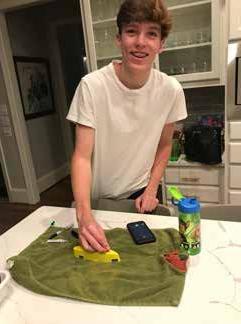
On race day, students, parents and teachers tuned in to YouTube live to watch the mini-boxcar race. A skeleton pit crew of faculty and staff observed social distancing rules to run the races using the SMES Boy Scout troop’s Pinewood Derby track and announced each round of racers and winners for those viewing from home. The race inspired a deep sense of community, with lots of cheering. Round one was all about speed with winners advancing to the semi-finals in four swift rounds of competition. In the end, team “CAP Air Force” clenched first place, even beating out the 8thgrade faculty “Scooby-Doo” car. Fifth-grade students and faculty voted to award team “Wii Games” with best theme, and a panel of administrators and teachers awarded team “Exotic Farmers” with best website. Eighth-grade s t u d e n t J a c k C u n n i n g h a m received the Carter Davis Spirit Award.
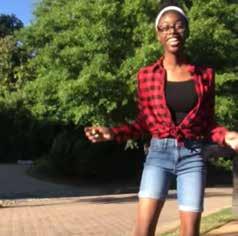
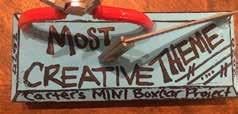
The annual boxcar project was created and named for Carter Davis, son of St. Martin’s 8th-grade English teacher Michele Davis, who passed away in August 2016.
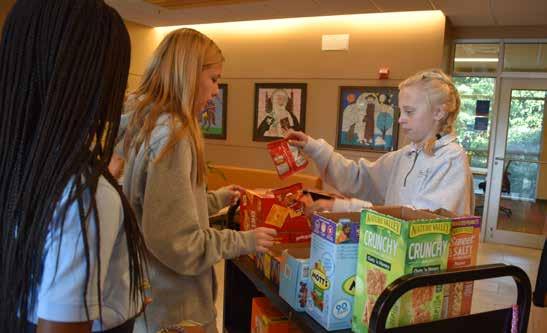
A Commendable Cart
8 BY KATHERINE DAVIS, 8TH GRADE
The snack cart: a commonly used phrase at SMES to define a cart stocked with an array of food where hungry Middle School students can buy snacks, talk with classmates, and add to the Student Council Charity Fund. At the price of 50 cents, students can buy anything from a crinkly Cheez-It bag to a glossy-red-wrapped fruit roll-up to enjoy outside with others. In addition, whenever a student buys a snack, they are chipping in to help the Student Council Charity Fund. The snack cart also is a way to catch up with friends. In the line, you can talk to classmates about the morning so far and even lend a quarter or two if other students forgot theirs. But something that adds even more to the cart’s brilliance is the people who give out the snacks. The very workers who help to man the stand are the students themselves. Elected student council representatives each man the stand and give up their snack break to make someone else’s even better. This teaches the students to be dependable and trustworthy as they have to keep track of which day is their “shift.” All in all, the snack cart is very beneficial to the St. Martin’s community because it provides food for the kids, teaches work ethic and trustworthiness, and plays a role in our culture of giving. For two great decades the snack cart has been feeding hungry students to boost
their energy and help them pay more attention in class. Seventh-grade math teacher Melissa Grier is the faculty supervisor of the snack cart. She said, “If you forget a snack, don’t bring enough snack, or know you have an activity after school, it’s nice to know the snack cart is there to save the day! Teachers appreciate being able to stop in and grab a snack sometimes, too.” Mrs. Grier is right, the snack cart is very helpful if a student forgets a snack, especially for after-school sports, because it gives them some energy before practice.

The snack cart is an integral part of St. Martin’s because it promotes good mor als and helps students give to others. Twelve years ago, as part of its culture of giving, the Middle School started a tradition to donate the money earned from snack sales to local charities. The student council has donated money to various charities of the council’s choosing, and in the past four years has raised a total of $23,500 for donation. Just last year, the student council split their earnings of $5,500 between five organizations: the Bella Vista Children’s Home, the Brookhaven Rotary Club Foundation, Episcopal Relief and Development, the Good Samaritan Health Center, and the Suthers Center for Christian Outreach. This yearly tradition has given many students a taste of our culture of giving, outreach, and hard work. Lastly, it adds something more to our school because instead of just having vending machines, you get to interact with real people. I believe our community is better because of it. All in all, this tradition has been beneficial to St. Martin’s and our community for two decades, and I’m sure it will continue to be in the future. Giving to communities, teaching hard work, and serving students, the snack cart will always live on as a special memory for St. Martin’s graduates. I hope that in the future we find new ways to make it even better and give the portable shop an even better array of “snackage” for kids. I think that the snack cart is a great addition for the school, and we wouldn’t be the same without it and its contributions to us. The snack cart is a lovely metaphor for our school because it is a place for people who have a hunger and are ready to ful fill it with the help of friends and teachers and also is a place to connect and talk to others and to learn the impact of giving.
Living Into Our Mission
A MAN-ON-THE-STREET INTERVIEW
8 BY ALEX HALL, 8TH GRADE
lthough I have only been at St. Martin’s for a mere three years, I have learned a lot about the school I am proud to call home. One of the exemplary things I val ue most about SMES is our mission statement: “St. Martin’s Episcopal School is dedicated to providing a quality education for the whole person in a loving, Christian atmosphere, which fosters lifelong learning.” It not only describes what SMES strives to be but also what students strive to do. I set out to travel the halls to learn how students experience the St. Martin’s mission every day. First stop, third grade. I asked a third grader how teachers encourage and incorporate the mission statement in the classroom. Lily Hewitt cheerfully stated that, “Teachers help us learn and grow throughout the day.” I wasn’t surprised to hear such an answer, and was happy to know that students are living into our mission. In Ms. Hurley’s class, students write in prayer books and are taught to be kind towards one another. When I asked for possible interviewees in the fifth-grade hall, two boys were quick to take me up on the offer, almost trampling me in the process. “We are challenged to think more, instead of one word answers we write sentences and paragraphs,” said Jake McLaren. “I think the teachers are doing a really good job of preparing us for Middle School.” Brewer Riley said, “[Teachers] work hard to find ways to make learning fun and not boring, [which] makes me feel better at

school.” Again, I was pleased with the results of what my peers had to say; they are happy at school, pleased with their work, and think highly of their hard-working teachers. After finishing up business in Warrior Hall, I passed by several Elementary students of mixed grades. I asked them what they thought of St. Martin’s and the vast majority said they didn’t ever want to leave. I began work again on the top floor of the Middle School building. “We are encouraged by teachers and each other to be kind and to think the best of others,” said seventhgrader Eloise Smith. “I try to be uplifting, compliment people and laugh with my friends a lot.” Seventh-grader Jack Breen offered his opinion as well, exclaiming that, “Our mission makes me feel more comfortable walking through the school doors, knowing
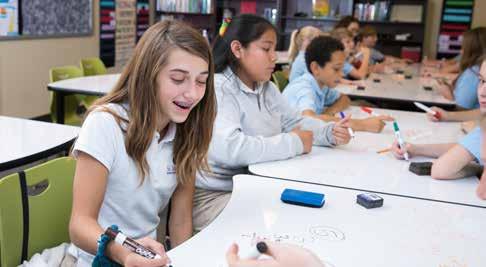
I will be cared for by my teachers, and be able to laugh and joke with friends too.” After my encounters with students, I have come to the conclusion that the St. Martin’s mission is actively present everyday in our school. From Lily Hewitt I learned about the ways SMES creates a “loving, Christian atmosphere.” After carefully listening to statements from Jake McLaren and Brewer Riley I connected their responses to “quality education for the whole person.” Seventh graders Eloise Smith and Jack Breen told me how teachers live out the mission and how the mission made them feel comfortable at school, showing how the school “fosters lifelong learning.” The school does an excellent job of incorporating the mission into our everyday lives, truly showing us how we can learn to live into our mission every day.
Sing, Say, Move and Play

by KAREN BOWER
EARLY CHILDHOOD MUSIC & MOVEMENT TEACHER
CHILDREN LEARN AND GROW THROUGH
PLAY. Intertwine music with play, and the benefits to a child’s brain development can be exponential, particularly in the areas of the brain used for language acquisition and reading. This harmony between play and musical education is fundamental to the Early Childhood Music and Movement program and is embodied in the program’s four core words—“Sing,” “Say,” “Move” and “Play”—that are prominently displayed in the classroom for all to see.
These four verbs indicate what students experience in each Music and Movement class. Instead of passively consuming musical concepts, St. Martin’s Toddler, Beginner, Pre-K and Kindergarten students comprehend terms such as tempo by dancing to fast and slow songs and rhythm by pounding on drums along with the beat. While students are actively learning, research shows that they are also developing their young brains, social-emotional skills and motor skills. The necessity of music in human brain development has been discussed as far back as ancient Greece. The Greeks believed the three primary areas of education are math for the development of a healthy brain, physical education for the development of a healthy body and music for the development of a healthy emotional sensitivity. Many schools around the country have decreased the amount of weekly instructional time students spend in music and physical education classes in an effort to increase the amount of time spent on core academic subjects. In contrast, St. Martin’s understands the importance of educating the whole child and schedules dedicated time for its youngest students to engage in song, dance, physical games and more in the form of weekly Music and Movement classes. It is my hope that along the way, students also learn to love music, as I did at a young age. I grew up in a musical household. My mother was a mu
sic teacher and my earliest musical memories are of my mother rocking and singing me to sleep at night. As a child, I sang with my siblings on car trips in threepart harmony, attended symphony concerts and was exposed to all genres of music. I started instruction on the piano as a young child, with my mom as my teacher, and eventually switched to the oboe in my middle school years. It was easy to fall in love with making music and being part of an ensemble. I loved the community aspect of making music together, as well as the individual challenge of achieving a high level of mastery. My passion for music continued to increase through college, so I set my eyes on a career as a professional musician with dreams to perform in an orchestra one day. Howev er, my tune changed in graduate school. I was hired by a local middle school to teach private lessons to their beginning oboe students. I fell in love with teaching and finding ways to motivate children to not only achieve at a high level but to truly love music, much like what my mom and music teachers did for me. So, I stepped off the stage and into the classroom. My first teaching job was at a public elementary school in an urban setting. Many of my students struggled both academically and socially and came from difficult home-life situations. For many of them, music class served as a safe place. This experience struck a lasting chord with me. It taught me even more about the power of music and its role in a child’s life. Music is so much more than a stimulant to intellectual development; it is also vital to a child’s so cial-emotional growth. As I grew in my career and then had my own children, I sought to learn more about how musical influences positively affect academ ic and social growth in the youngest of children. After attending Kindermusik classes with my own two boys, I became certified to teach infant, toddler and preschool music and movement classes and started my own business. It was exciting to see the growth of babies and the bonding that music nurtured between them and their parents.
MUSIC AND MOVEMENT IN ACTION
Earlier this year, I took Music Rhapsody’s online Early Childhood Music and Move ment certification course and attended a
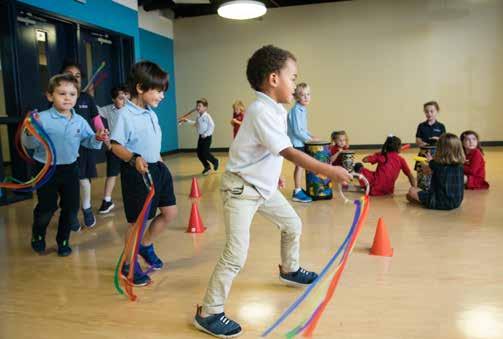
Allowing children at a young age to make music in an active and joyful setting...increases the likelihood that they will continue to engage in musical experiences later in life.
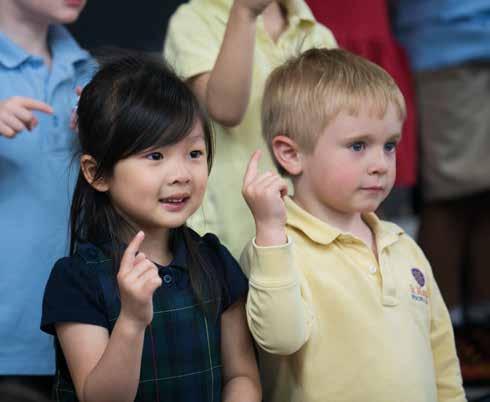
live training with Lynn Kleiner, the author of that curriculum. Kleiner is someone who truly makes music come alive for young children, and the lessons I brought back to the classroom have already become some of my students’ favorites. Pre-K and Kindergarten students love Kleiner’s action song, “Subnivean.” They learn that subnivean means “below the snow” and we talk about which creatures might live there. This type of visual leads to immediate movement ideas for children. Little mice, moles and other creatures suddenly begin “digging” around the classroom, remaining watchful for predators that can hear them, even from far away. This ties in wonderfully to science, where students learn about predators from their homeroom teachers and in the Science Lab. The scene quickly changes as the children react to the lyrics: “when they are done and they’re looking for fun, they dig to the top and they’re ready to run!” Squeals of delight and a chorus of “can we sing that again, Ms. Bower?” confirm that I have found a good lesson. In St. Martin’s Music and Movement class es, quite simply, children “do music.” Just as the classroom signs say, everyday we “Sing,” “Say,” “Move,” and “Play.” Allowing children at a young age to make music in an active and joyful setting not only helps to develop their young minds but also increases the likelihood that they will continue to engage in musical experiences later in life when it becomes a choice. This is what I hope for my young students!
The Science Behind Music and Movement
The theories on brain development in young children are as numerous as note combinations on a keyboard. Howard Gardner’s theory of multiple intelligences supports the importance of a variety of early learning experiences. In his book, “Multiple Intelligences,” Gardner suggests that each individual possesses a variety of “intelligences” that function independently of other intellectual attributes. In Early Childhood Music and Movement class, we work to develop both the musical and bodily-kinesthetic “intelligences.” Preschoolers love music, and they retain music concepts best when paired with movement. Presenting music concepts first from a movement experience prepares their brains to attach those experiences to what they hear. Activities in Music and Movement class are designed to stimulate development in every part of the young child’s brain: hearing, vision, speech, behavior, sensory reactions, memory and emotions. By combining music with movement, we follow a curriculum that helps preschoolers develop gross and fine motor skills, body awareness and coordination.
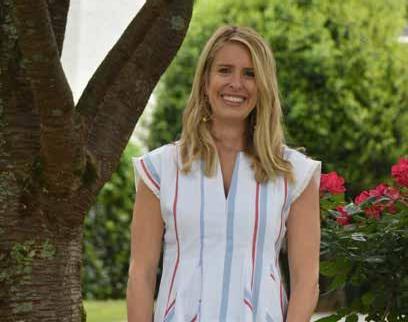
When did your family become part of the St. Martin’s community?
Our family joined the St. Martin’s community in 2012 when our oldest of three, Tate, a rising 8th grader, enrolled for Kindergarten. I can’t believe we have been at St. Martin’s for nine years. Time flies!
In what capacities have you volunteered at SMES (in and out of the classroom)?
I love that St. Martin’s provides so many volunteering opportunities for parents. I started off volunteering in smaller roles with the PTO, then spent a few years adding the job of room parent, and later had the pleasure of serving as PTO copresident for the 2017-2018 school year. Over the last two years, I have also helped coach the girls’ C volleyball team, and I’ve been doing a lot of merchandise buying for the school store. Also, I currently serve on the Board of Trustees.
Why is the SMES school store important to the community?
Over my nine years at St. Martin’s, it has been amazing to see the school store slowly expand from selling mostly toys, school supplies and a few t-shirts to selling a wide variety of new apparel and spirit items. The PTO and school administration have had a goal to “update and expand” the school’s sweatshirts and other spirit gear,
Volunteer Spotlight Jennifer O’Leary
and I’ve been doing some work behind the scenes to help make it happen. This past year, with the support of our administration, we tackled the roll-out of hooded St. Martin’s sweatshirts, and the effort has been a huge hit! We’ve been amazed by the overwhelming response to these sweatshirts. To walk onto campus and see all the kids (even in 96 degree weather!) wearing their sweatshirts proudly, made me realize how important our school store was to supplying needed and wanted spirit items. It has made St. Martin’s look and feel like a real school community. I LOVE being out in the broader community and seeing kids proudly wear their sweatshirts outside of school. Call it school spirit or pride; I think it looks amazing and makes me smile and feel happy to be a part of our special St. Martin’s community.
Why is giving back to St. Martin’s important to you?
When I was growing up, I was taught, “you get what you put in.” Giving back my time has allowed me to become more a part of the school community and see first-hand all of the fantastic experiences St. Martin’s is providing to my children. I think it sets an important example for my children to see me giving back to their school community; and outside the community as well. Quite frankly, giving back to St. Martin’s just feels good.
What makes St. Martin’s special to you and your family?
St. Martin’s has been such a special place because we have seen our three children really grow, mature, and excel here. Our entire family has met so many wonderful families, and we have made life-long friends. I am sad thinking about my oldest graduating in 2021 and leaving the school. That feeling is probably one of the greatest compliments I can give the faculty, administration and school community.
Joined St. Martin’s community:
2012-2013
Volunteer Areas:
• PTO • Room Parent • PTO Co
President • Coaching Girls’
C Volleyball • Buyer for school store • SMES Board of
Trustees

